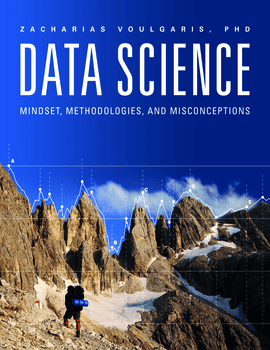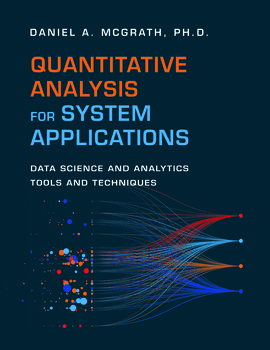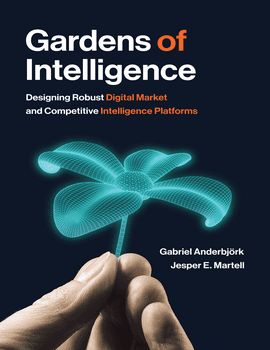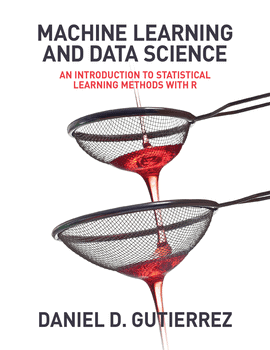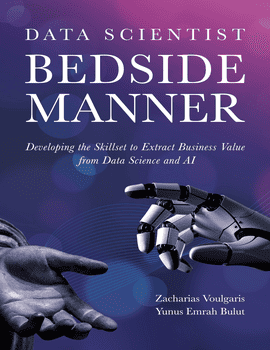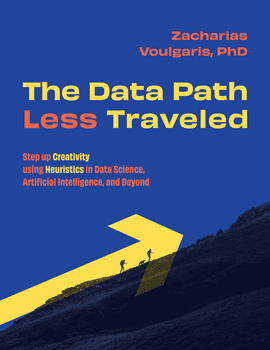Data Science Mindset, Methodologies, and Misconceptions
Data Science: Mindset, Methodologies, and Misconceptions, by Dr. Zacharias Voulgaris
Master the concepts and strategies underlying success and progress in data science.
Topics
CHAPTER 1: What is Data Science?
Data Science vs. Business Intelligence vs. Statistics
Data Science
Business Intelligence
Statistics
Big Data, Machine Learning, and AI
Big Data
Machine Learning
AI – The Scientific Field, Not the Sci-fi Movie!
The Need for Data Scientists and the Products/Services Provided
What Does a Data Scientist Actually Do?
What Does a Data Scientist Not Do?
The Ever-growing Need for Data Science Professionals
Summary
CHAPTER 2: The Data Science Pipeline
Data Engineering
Data Preparation
Data Exploration
Data Representation
Data Modeling
Data Discovery
Data Learning
Information Distillation
Data Product Creation
Insight, Deliverance, and Visualization
Putting It All Together
Summary
CHAPTER 3: Data Science Methodologies
Predictive Analytics
Classification
Regression
Time-series Analysis
Anomaly Detection
Text Prediction
Recommender Systems
Content-based Systems
Collaborative Filtering
Non-negative Matrix Factorization (NMF or NNMF)
Automated Data Exploration Methods
Data Mining
Association Rules
Clustering
Graph Analytics
Dimensionless Space
Graph Algorithms
Other Graph-related Topics
Natural Language Processing (NLP)
Sentiment Analysis
Topic Extraction/Modeling
Text Summarization
Other NLP Methods
Other Methodologies
Chatbots
Artificial Creativity
Other AI-based Methods
Summary
CHAPTER 4: The Data Scientist’s Toolbox
Database Platforms
SQL-based Databases
NoSQL Databases
Graph-based Databases
Programming Languages for Data Science
Julia
Python
R
Scala
Which Language is Best for You?
The Most Useful Packages for Julia and Python
Other Data Analytics Software
MATLAB
Analytica
Mathematica
Visualization Software
Plot.ly
D3.js
WolframAlpha
Tableau
Data Governance Software
Spark
Hadoop
Storm
Version Control Systems (VCS)
Git
Github
CVS
Summary
CHAPTER 5: Data Science Questions and Hypotheses
Importance of Asking (the Right) Questions
Formulating a Hypothesis
Questions Related to Most Common Use Cases
Is Feature X Related to Feature Y?
Is Subset X Significantly Different to Subset Y?
Do Features X and Y Collaborate Well with Each Other for Predicting Variable Z?
Should We Remove X from the Feature Set?
How Similar are Variables X and Y?
Does Variable X Cause Variable Y?
Other Question Types
Questions Not to Ask
Summary
CHAPTER 6: Data Science Experiments and Evaluation of Their Results
The Importance of Experiments
How to Construct an Experiment
Experiments for Assessing the Performance of a Predictive Analytics System
A Matter of Confidence
Evaluating the Results of an Experiment
Summary
CHAPTER 7: Sensitivity Analysis of Experiment Conclusions
The Importance of Sensitivity Analysis
The Butterfly Effect
Global Sensitivity Analysis Using Resampling Methods
Bootstrapping
Permutation Methods
Jackknife
Monte Carlo
Local Sensitivity Analysis Employing “What If?” Questions
Some Useful Considerations on Sensitivity Analysis
Summary
CHAPTER 8: Programming Bugs
The Importance of Understanding and Dealing with Programming Bugs
Places You Usually Find Bugs
Types of Bugs Commonly Encountered
Some Useful Considerations on Programming Bugs
Summary
CHAPTER 9: Mistakes Through the Data Science Process
How Mistakes Differ From Bugs
Most Common Types of Mistakes
Choosing the Right Model
Value of a Mentor
Some Useful Considerations on Mistakes
Summary
CHAPTER 10: Handling Bugs and Mistakes
Strategies for Coping with Bugs
Strategies for Coping with High-level Mistakes
Preventing Erroneous Situations in the Pipeline
Types of Models
Evaluating the Data at Hand and Pairing It with a Model
Choosing the Right Model for a Classification Methodology
Combining Different Options in an Ensemble Setting
Other Considerations for Choosing the Right Model
Summary
CHAPTER 11: The Role of Heuristics in Data Science
Heuristics as Information in the Making
Problems that Require Heuristics
Why Heuristics are Essential for an AI System
Applications of Heuristics in Data Science
Heuristics and Machine Learning Processes
Custom Heuristics and Data Engineering
Heuristics for Feature Evaluation
Other Applications of Heuristics
Anatomy of a Good Heuristic
Some Final Considerations on Heuristics
Summary
CHAPTER 12: The Role of AI in Data Science
Problems AI Solves
Types of AI Systems Used in Data Science
Deep Learning Networks
Autoencoders
Other Types of AI Systems
AI Systems Using Data Science
Computer Vision
Chatbots
Artificial Creativity
Other AI Systems Using Data Science
Some Final Considerations on AI
Summary
CHAPTER 13: Data Science Ethics
The Importance of Ethics in Data Science
Confidentiality Matters
Privacy
Data Anonymization
Data Security
Licensing Matters
Other Ethical Matters
Some Final Considerations on Ethics
Summary
CHAPTER 14: Future Trends and How to Remain Relevant
General Trends in Data Science
The Role of AI in the Years to Come
Big Data: Getting Bigger and More Quantitative
New Programming Paradigms
The Rise of Hadoop Alternatives
Other Trends
Remaining Relevant in the Field
The Versatilist Data Scientist
Data Science Research
The Need to Educate Oneself Continuously
Collaborative Projects
Mentoring
Summary
From the author of the bestsellers, Data Scientist and Julia for Data Science, this book covers four foundational areas of data science. The first area is the data science pipeline including methodologies and the data scientist’s toolbox. The second are essential practices needed in understanding the data including questions and hypotheses. The third are pitfalls to avoid in the data science process. The fourth is an awareness of future trends and how modern technologies like Artificial Intelligence (AI) fit into the data science framework.
The following chapters cover these four foundational areas:
- Chapter 1 – What Is Data Science?
- Chapter 2 – The Data Science Pipeline
- Chapter 3 – Data Science Methodologies
- Chapter 4 – The Data Scientist’s Toolbox
- Chapter 5 – Questions to Ask and the Hypotheses They Are Based On
- Chapter 6 – Data Science Experiments and Evaluation of Their Results
- Chapter 7 – Sensitivity Analysis of Experiment Conclusions
- Chapter 8 – Programming Bugs
- Chapter 9 – Mistakes Through the Data Science Process
- Chapter 10 – Dealing with Bugs and Mistakes Effectively and Efficiently
- Chapter 11 – The Role of Heuristics in Data Science
- Chapter 12 – The Role of AI in Data Science
- Chapter 13 – Data Science Ethics
- Chapter 14 – Future Trends and How to Remain Relevant
Targeted towards data science learners of all levels, this book aims to help the reader go beyond data science techniques and obtain a more holistic and deeper understanding of what data science entails. With a focus on the problems data science tries to solve, this book challenges the reader to become a self-sufficient player in the field.
About Zack
Dr. Zacharias Voulgaris was born in Athens, Greece. He studied Production Engineering and Management at the Technical University of Crete, shifted to Computer Science through a Masters in Information Systems & Technology, and then to Data Science through a PhD in Machine Learning. He has worked at Georgia Tech as a Research Fellow, at an e-marketing startup in Cyprus as an SEO manager, and as a Data Scientist in both Elavon (GA) and G2 Web Services (WA). He also was a Program Manager at Microsoft on a data analytics pipeline for Bing. Zacharias has authored several books on Data Science, mentors aspiring data scientists, and maintains a Data Science and AI blog. Currently, he works as a consultant at GLG.
Faculty may request complimentary digital desk copies
Please complete all fields.
